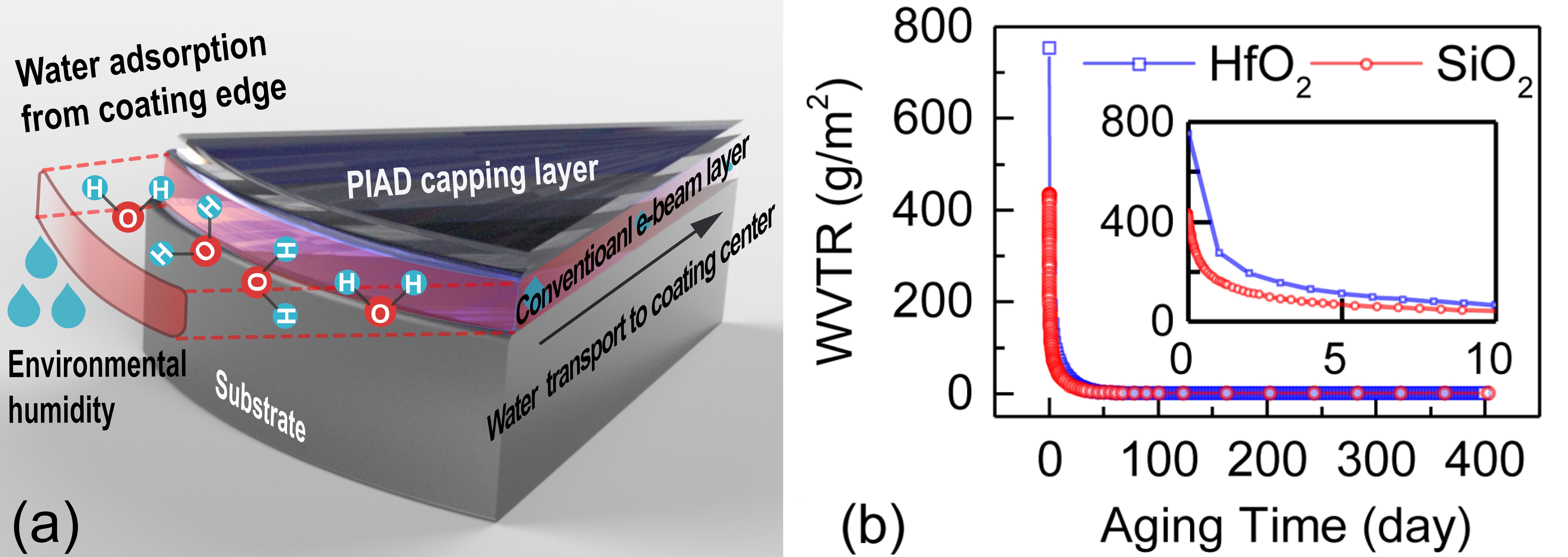
Electron-beam (e-beam) deposited large-aperture high-reflection multilayer coatings are key components in large laser facilities, steering the laser from the amplifiers to the final optical assembly. Due to the porous nature, the properties of the e-beam coating are sensitive to ambient humidity. The adsorption and/or desorption of water molecules is the main cause of e-beam coating performance instability, which may even degrade the performance and stability of the entire laser system. However, the water adsorption during coating exposure from the vacuum chamber to the air environment is almost “instantaneous”, which makes the moisture-sensitive properties related to the water vapor transmission rate (WVTR) and the underlying mechanism not easy to get.
One recent study conducted by a research team from Shanghai Institute of Optics and Fine Mechanics, Chinese Academy of Sciences, revealed the effects of water adsorption on properties of e-beam HfO2/SiO2 high-reflection coatings. The result was published in Thin Solid Films.
In this work, researchers employed a dense plasma-ion-assisted-deposition SiO2 capping layer to reduce the water-accessible surface of e-beam coating by isolating the top surface from ambient humidity. The capped top surface extended the originally rapid water adsorption process of e-beam coating because water could only penetrate the sidewalls of the coating, which made it possible to measure or trace the WVTR of e-beam coating and gain a deeper understanding of the moisture-induced instability of e-beam coating as well.
Spectral measurements suggested that four water adsorption steps, including filling, stabilization, swelling and refilling, led to the overall redshift and short-term fluctuations in spectra. The stress and Fourier transform infrared analysis revealed that water infiltration led to spectral red-shift and increasing compressive stress firstly. Then the compressive stress started to release once tensile component and occupy occupied the dominance owing to hydration reaction, swelling-induced relaxation in coating matrix, and ice-like/ice structure water in coating pores. With the help of the capping layer, a model based on the finite element method was proposed to calculate the water vapor transmission rate of e-beam coatings.
This study on the underlying mechanism of moisture-induced instability of e-beam coating provides theoretical and experimental experience for improving the stability of e-beam coating, which is helpful to ensure the reliability and stability of large laser systems.
This work was supported by National Special Support Program for Young Top-notch talent; National Natural Science Foundation of China; Youth Innovation Promotion Association of the Chinese Academy of Sciences; Shanghai Young Top-notch Talent Program; Strategic Priority Research Program of the Chinese Academy of Sciences.

Schematic diagram of water transportation in coating with a capping layer and the WVTR of HfO2 and SiO2 layers in a capped multilayer coating versus aging time. The inset shows the data for the first 20 days. (Image by SIOM)

86-10-68597521 (day)
86-10-68597289 (night)

86-10-68511095 (day)
86-10-68512458 (night)

cas_en@cas.cn

52 Sanlihe Rd., Xicheng District,
Beijing, China (100864)

